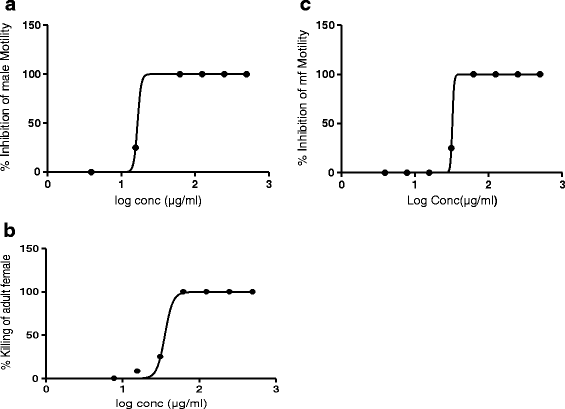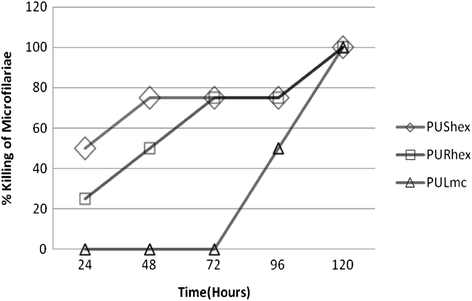Filaricidal activities on Onchocerca ochengi and Loa loa, toxicity and phytochemical screening of extracts of Tragia benthami and Piper umbellatum
- PMID: 27576736
- PMCID: PMC5004253
- DOI: 10.1186/s12906-016-1319-2
Filaricidal activities on Onchocerca ochengi and Loa loa, toxicity and phytochemical screening of extracts of Tragia benthami and Piper umbellatum
Abstract
Background: Onchocerciasis is the world's second leading infectious cause of blindness. Its control is currently hampered by the lack of a macrofilaricidal drug and by severe adverse events observed when the lone recommended microfilaricide, ivermectin is administered to individuals co-infected with Loa loa. Therefore, there is the need for a safe and effective macrofilaricidal drug that will be able to cure the infection and break transmission cycles, or at least, an alternative microfilaricide that does not kill L. loa microfilariae (mf).
Methods: Fourteen extracts from two medicinal plants, Tragia benthami and Piper umbellatum were screened in vitro against Onchocerca ochengi parasite and L. loa mf. Activities of extracts on male worms and microfilariae were assessed by motility reduction, while MTT/Formazan assay was used to assess biochemically the death of female worms. Cytotoxicity and acute toxicity of active extracts were tested on monkey kidney cells and Balb/c mice, respectively.
Results: At 500 μg/mL, all extracts showed 100 % activity on Onchocerca ochengi males and microfilariae, while 9 showed 100 % activity on female worms. The methylene chloride extract of Piper umbellatum leaves was the most active on adult male and female worms (IC50s: 16.63 μg/mL and 35.65 μg/mL, respectively). The three most active extracts on Onchocerca ochengi females were also highly active on Loa loa microfilariae, with IC50s of 35.12 - 13.9 μg/mL. Active extracts were generally more toxic to the worms than to cells and showed no acute toxicity to Balb/c mice. Phytochemical screening revealed the presence of saponins, steroids, tannins and flavanoids in the promising extracts.
Conclusions: These results unfold potential sources of novel anti-Onchocerca lead compounds and validate the traditional use of the plants in onchocerciasis treatment.
Keywords: Loa loa; Onchocerciasis; Piper umbellatum; Tragia benthami.
Figures
Similar articles
-
Review on medicinal plants and natural compounds as anti-Onchocerca agents.Parasitol Res. 2018 Sep;117(9):2697-2713. doi: 10.1007/s00436-018-6003-7. Epub 2018 Jul 15. Parasitol Res. 2018. PMID: 30008135 Review.
-
Filaricidal properties of Lantana camara and Tamarindus indica extracts, and Lantadene A from L. camara against Onchocerca ochengi and Loa loa.PLoS Negl Trop Dis. 2018 Jun 13;12(6):e0006565. doi: 10.1371/journal.pntd.0006565. eCollection 2018 Jun. PLoS Negl Trop Dis. 2018. PMID: 29897908 Free PMC article.
-
Anti-Onchocerca activity and phytochemical analysis of an essential oil from Cyperus articulatus L.BMC Complement Altern Med. 2014 Jul 7;14:223. doi: 10.1186/1472-6882-14-223. BMC Complement Altern Med. 2014. PMID: 24998345 Free PMC article.
-
Macro and microfilaricidal activities of extracts of Annona senegalensis and Milletia comosa against Onchocerca ochengi and Loa loa.Exp Parasitol. 2019 Mar;198:71-78. doi: 10.1016/j.exppara.2019.02.004. Epub 2019 Feb 13. Exp Parasitol. 2019. PMID: 30771293
-
Onchocerca ochengi infections in cattle as a model for human onchocerciasis: recent developments.Parasitology. 2000;120 Suppl:S133-42. doi: 10.1017/s0031182099005788. Parasitology. 2000. PMID: 10874716 Review.
Cited by
-
Evaluation of macrofilaricidal and microfilaricidal activities against Onchocerca ochengi and cytotoxicity of some synthesized azo compounds containing thiophene backbone.Parasitol Res. 2021 Jun;120(6):2087-2094. doi: 10.1007/s00436-021-07162-3. Epub 2021 Apr 17. Parasitol Res. 2021. PMID: 33864105
-
Macrofilaricidal Activity, Acute and Biochemical Effects of Three Lichen Species Found on Mount Cameroon.J Parasitol Res. 2022 Jan 7;2022:1663330. doi: 10.1155/2022/1663330. eCollection 2022. J Parasitol Res. 2022. PMID: 35036001 Free PMC article.
-
Review on medicinal plants and natural compounds as anti-Onchocerca agents.Parasitol Res. 2018 Sep;117(9):2697-2713. doi: 10.1007/s00436-018-6003-7. Epub 2018 Jul 15. Parasitol Res. 2018. PMID: 30008135 Review.
-
In vitro nematocidal potential of hydro-ethanolic and aqueous extracts of Calotropis procera (Aiton) W.T. Aiton, 1811 (Apocynaceae) and Faidherbia albida (Delile) A. Chev., 1934 (Fabacae) against Onchocerca ochengi and Caenorhabditiselegans.Heliyon. 2023 May 18;9(5):e16379. doi: 10.1016/j.heliyon.2023.e16379. eCollection 2023 May. Heliyon. 2023. PMID: 37251817 Free PMC article.
-
The Functional Parasitic Worm Secretome: Mapping the Place of Onchocerca volvulus Excretory Secretory Products.Pathogens. 2020 Nov 23;9(11):975. doi: 10.3390/pathogens9110975. Pathogens. 2020. PMID: 33238479 Free PMC article. Review.
References
-
- World Health Organization: Global Initiative for the Elimination of Avoidable Blindness, Action Plan 2006 – 2011. WHO; 2007:29 [http://www.who.int/blindness/Vision2020_report.pdf]
-
- Wanji S. Rapid assessment procedures for loiasis. Report of a multi-centre study. UNDP/World Bank/ WHO special programme for research and training in tropical diseases (TDR). 2001; 38p.
-
- Turner JD, Tendonfor N, Esum M, Johnson KL, Langley RS, Ford L, Faragher B, Specht S, Mand S, Hoeraf A, Enyong P, Wanji S, Taylor MJ. Macrofilaricidal activity after doxycycline onlytreatment of Onchocerca volvulus in an area of Loa loa co-endemicity: a randomized control trial. PLoS Negl Trop Dis. 2010;4:4. doi: 10.1371/journal.pntd.0000660. - DOI - PMC - PubMed
MeSH terms
Substances
LinkOut - more resources
Full Text Sources
Other Literature Sources



